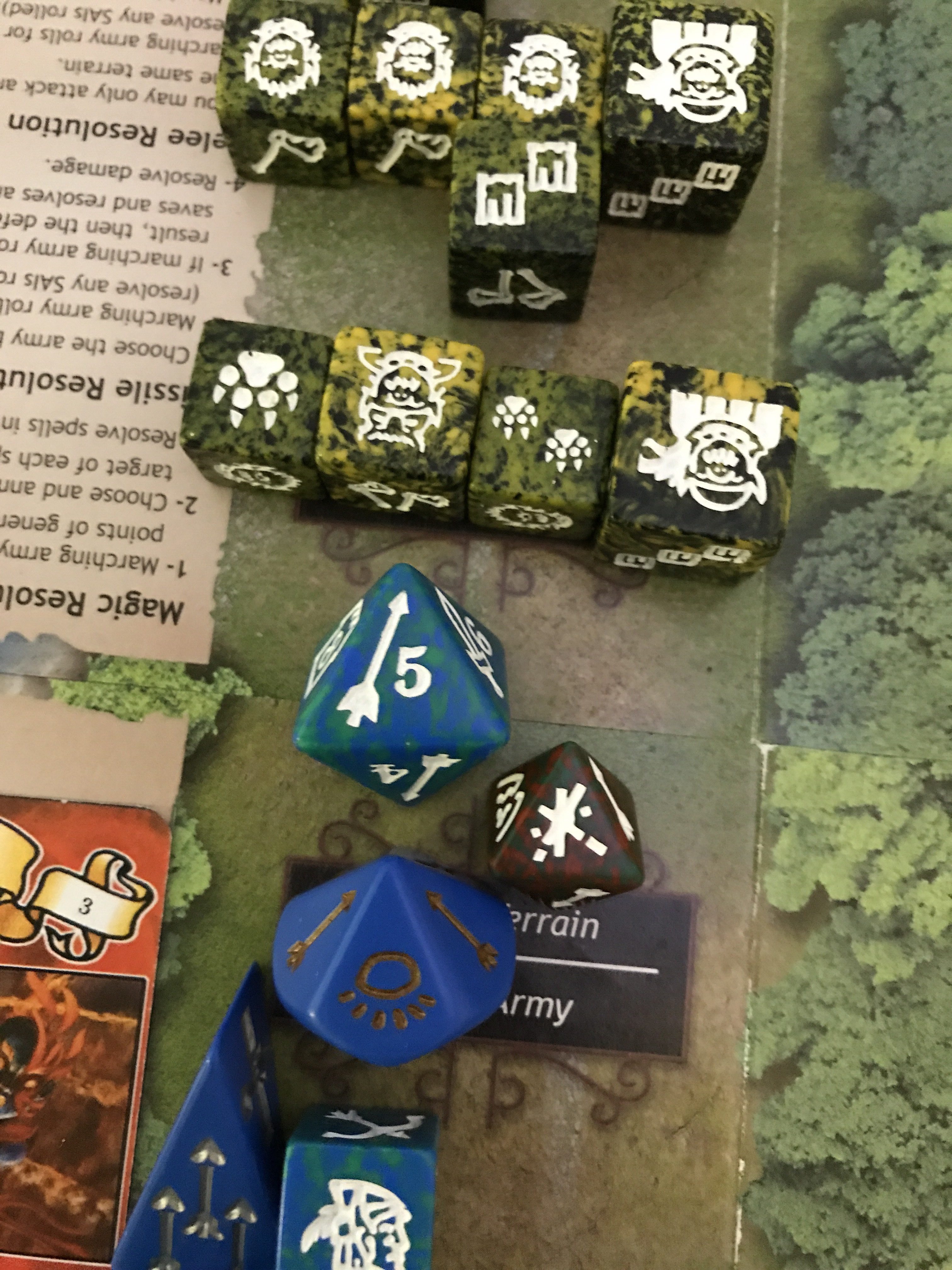As a consequence of a discussion a few nights ago, Jeff Denmon and I decided that it would be a good idea to pool resources and take an in-depth look at Dragons. This is the first part of this series which, we hope, will prove interesting and useful to new and seasoned Dragon Dice players alike.
In this part, I will be taking a look at the actions behind the icons, what they mean, taking a look at the Wyrm and Drake types of elemental dragon and then looking into the probabilities of the various outcomes.
Types of Dragon
There are two types of dragon, coming in a variety of colours. The types are:-
- Wyrm – This dragon has no wings and therefore does does not fly away of its own volition. It has 3 tail faces, meaning that 1 in 4 rolls (3 out of 12) will give a re-roll chance against an army and 1 in 3 rolls (4 out of 12) giving a re-roll against another Dragon. The treasure face only applies when attacking an army, and has no result, other than its automatic save, against another Dragon.
- Drake – This Dragon has wings, which means that as a result of 1 in 6 rolls (2 out of 12), it will fly away. It only has 2 tail faces, meaning that a re-roll has a 1 in 6 chance against an army, and a 1 in 4 chance against another Dragon.
Both Wyrm and Drake have an automatic 5 saves, unless they roll a Belly. Both have 5 health.
Dragon Colours
- Elemental – Single Colour Red, Yellow, Green, Blue or Black
- Ivory – Single Colour Ivory
- White – Single Colour White
- Elemental Hybrid – 2 colour mix of Red, Yellow, Green, Blue and Black
- Ivory Hybrid – 2 Colour mix of Ivory with Red, Yellow, Green, Blue or Black
For the purposes of this article, I will only be looking at properties pertaining to all colours of Dragon. We will be looking at tactical differences with Ivory, White and the Various hybrids in the near future.
The Icons
- Jaws – 12 Damage
- Breath – 5 Non-Defensible Damage + Elemental Breath Effect (See below) against Army, 5 Damage + Re-Roll against Dragon.
- Claw – 6 Damage
- Tail – 3 Damage + Re-Roll
- Wing – 5 Damage + Dragon Departs
- Belly – 0 Damage + Dragon loses Automatic Saves
- Treasure – 0 Damage + Army can recruit 1 unit.
Dragon Breath
Use of Dragons
There are two main reasons for summoning a Dragon in the game of Dragon Dice. These are:-
- To attack an opposing army with a Dragon.
- To stop your own army from being attacked by a Dragon.
Both of these are treated in different ways, and are addressed separately. This time I am looking at Dragon v Armies.
Dragon v Army Statistics
A Dragon is pretty limited in what it can do, being restricted to a combination of the following actions:-
- Inflicting Damage
- Saving
- Breath Attack
- Treasure
- Flying Away.
The table above shows that the Wyrm has an expected damage value of 5.556 with a standard deviation of 3.592. The Drake has a slightly higher expected value of 5.7, but a lower standard deviation. This indicates that the damage results of the Drake are slightly more consistent than those of the Wyrm.

This table shows the relative possible scores that can be obtained during the attack of a single dragon, including re-rolls. Higher values, although possible, are highly unlikely, and have therefore not been included. These figures are better seen on a graph.
As can be seen here, the Drake is showing that it is most likely to give a result of 5 or 6, whereas the Wyrm is showing to be slightly more likely to obtain 3, 9, 12 and 15 etc. Unfortunately, it is also more likely to generate zero results (25% of the time).

This last table shows that the Wyrm is also slightly more fragile than the Drake, but has more staying power owing to the Drake’s wings.
Dragon v Dragon Statistics
Against another Dragon, the possibilities are:
- Inflicting Damage
- Saving
- Flying Away

The table above shows that the Wyrm has an expected damage value of 6.250 with a standard deviation of 3.913. The Drake has a slightly higher expected value of 6.333, but a lower standard deviation of 3.420. This indicates that the damage results of the Drake are slightly more consistent than those of the Wyrm.


This table shows that, although the Drake is more likely to take a another dragon if it rolls a belly, the Wyrm is more likely to take out another dragon if it does not roll a belly.
The 5 points of damage given by the wings of the drake are making the chance of getting 5 of more hits against another dragon a significant advantage that needs to be considered if using a Dragon to fight another dragon, as opposed to an army.
I am hoping that Jeff will be doing his tactical analysis on these figures in the near future.
















